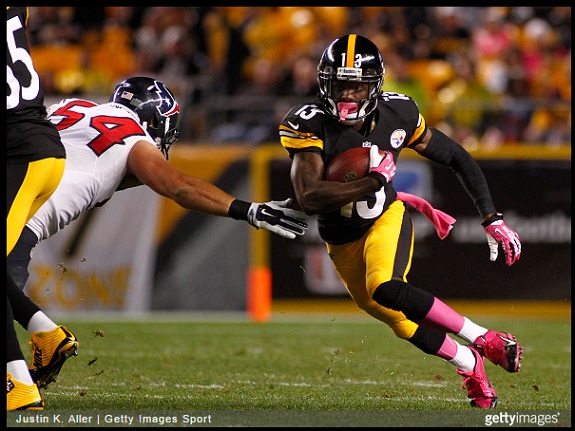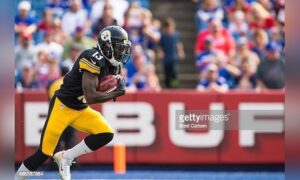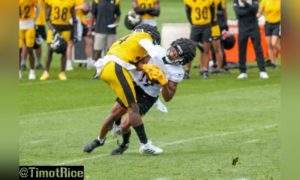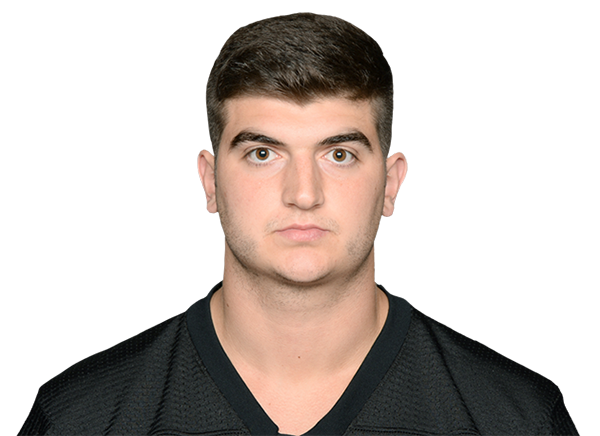It’s said a draft class can’t be fully graded until at least three years after the picks are made. That’s why after submitting grades for every Pittsburgh Steelers pick made in 2021, I began going back through and grading previous Steeler draft classes beginning with 2018. Today continues the fifth class in that exercise, with the Steelers’ third-round pick in the 2014 NFL Draft: Dri Archer, an offensive weapon from Kent State.
This exercise follows the six viewpoints (listed below) for examining and re-grading a pick. Each of the first five viewpoints gets examined and assigned a letter grade, before taking that analysis and combining it into a final letter grade. Those five viewpoints comprise much of what goes into the draft grades consumed by so many every year after the draft.
Steelers’ Career: What did the player contribute to the team that drafted him?
NFL Career: Did the player make the pick look better in hindsight after leaving Pittsburgh?
Pick Value: Did the player outperform his draft slot? Did he fail to live up to the pick used on him?
Positional Value: Was the player the best player remaining at his specific position in the draft?
Other Options: Did any players go during the next round that were better selections?
Overall Grade: A final mark to denote whether the selection was an overall positive one, or one better spent elsewhere.
Each factor in a retrospective doesn’t apply evenly to every pick made; consider the grades weighted. For example, to return a high grade in pick value, a first-round pick should have a long and impactful career, while a later-round pick needs only a couple seasons as a back-up or modest contributor to be worth the selection used on him.
Some factors are universal, though. Whether picked first overall or 259th, there will always be other options on the board to compare the player to, and steals and reaches can come from any place in the draft.
Round 3, Pick 33: Dri Archer, RB/WR/KR, Kent State
STEELERS & NFL CAREER: F
People familiar with MAC football and aware of the Kent State football program knew the potential Dri Archer offered as a truly dynamic weapon for an offense. The diminutive speedster (5’8″, 173 pounds) off-set three sub-par seasons with the Golden Flashes with an All-American 2012 season, when he ran for 16 touchdowns and almost 1,500 yards, caught 39 passes for 561 yards and four touchdowns, and returned three kickoffs for touchdowns, averaging over 36 yards per return on 16 total.
Anyone not aware of his potential became aware at the Scouting Combine, when Archer ran the 40-yard dash in 4.26 seconds, still the third-fastest time in history. That shot his stock straight up, and the Steelers were the team to bite with the first compensatory pick of the draft, 97th overall. Running back, wide receiver, return specialist, the options were fun to envision for Archer at the NFL level.
Instead, his career was none of the above, and very, very brief. Archer hardly got onto the field as a rookie in 2014, with Le’Veon Bell dominating the backfield and all the targets going to Antonio Brown, Markus Wheaton, Martavis Bryant, and Heath Miller. Archer got 10 total carries (for 40 yards), caught seven passes (for 23 yards), and returned nine kicks for under an 18-yard average. In total, all of Archer’s versatility earned him 102 cumulative snaps as a rookie on a Steeler offense with most of the main spots already occupied.
None of those names left the offense in 2015, but Archer did. He played only three snaps on offense all season without a carry or reception. An increased role as a return man, with 14 kick returns for a 25-yard average, kept him involved with the team, but Archer saw only 41 snaps that year. The outcome was apparent early on, and didn’t need to wait until the offseason to materialize. Pittsburgh released Archer midway through that season.
Archer’s football career had two more brief stops, but he never saw a field again after returning those kicks for the Steelers. The New York Jets picked him up and cut him during the 2016 offseason, and Archer refused to report to the Buffalo Bills when they claimed him off waivers from the Jets. In total, one of the three fastest players to ever enter the NFL played 143 snaps.
PICK VALUE: F
Pittsburgh drafted Archer to contribute in some way as a weapon for the team’s offense and/or special teams. Instead, Archer ended up buried at several spots on the depth chart and barely saw the field for the franchise. For a Day 2 selection, that just doesn’t cut it. Not even making it through a full second season only adds to this pick being a big miss after an outstanding start to the 2014 draft.
POSITIONAL VALUE: D
Archer could get compared either to the receivers or the running backs taken from this point forward in the draft. And he is in line with a lot of the other receivers taken, who failed to stick in the NFL. From the 97th pick on, the leading receiver from the class is Bryant with 2,183 yards, his Steeler teammate and someone getting his own retrospective in the coming days. None of the receivers remain active in the NFL today, with Quincy Enunwa (209th, New York Jets) the closest to making it to that point. All did have careers better than Archer, but not what you would consider tremendous ones.
There were some heavier hitters remaining at the running back position, though, and that is what helps drive this grade down considerably. The very next back taken after Archer was Devonta Freeman (103rd, Atlanta), a two-time Pro Bowler with two 1,000-yard seasons as the starter for the Falcons. The fourth round kept it coming with James White (130th, New England), who became Tom Brady’s signature pass-catching back with the Patriots and won three Super Bowl rings. And later on in the sixth went Alfred Blue (181st, Houston), who topped 2,400 yards over five seasons with the Texans.
But the absolute best player to compare Archer to is the player who became what Archer didn’t: De’Anthony Thomas, drafted 124th by Kansas City. The Oregon product starred as a runner, receiver, and returner for the Ducks, and brought the same versatility to the NFL that Archer did. Kansas City phased out his running to focus on using him as a returner and a depth receiver, and Thomas won a Super Bowl with them while playing six seasons in the league. He never topped 23 receptions or 156 yards receiving in his career, but did return 166 combined kicks and punts, and add a dynamic to the team’s offense.
OTHER OPTIONS: D
Freeman and Thomas pop up again as alternatives, each taken within the next round of picks from Archer. Freeman is the closest a player in that range got to being an absolute “home run,” but plenty stuck around to put together lengthier NFL careers.
A Super Bowl champion with Kansas City and now on his fourth team, Bashaud Breeland (102nd, Washington) has started seven seasons in the league as a cornerback. Aaron Colvin (114th, Jacksonville) is out of the league now, but earned a big-money deal from the Houston Texans to play corner before he left. Tre Boston (128th, Carolina) keeps the run on defensive backs going, starting six seasons in the league for several franchises.
Mentioned in yesterday’s Stephon Tuitt retrospective, DaQuan Jones (112th, Tennessee) spent six years starting for the Titans along the defensive line. And mentioned in Ryan Shazier’s retro, Anthony Hitchens (119th, Dallas) has started every season at linebacker and won a Super Bowl starting for Kansas City. And a late revelation last season, Logan Thomas (120th, Arizona) underwent a renaissance from a failed quarterback prospect to an athletic tight end for Washington.
OVERALL GRADE: F
Archer remains a prospect with plenty to brag about from his Kent State days, and someone who will always be one of the fastest players to ever take an NFL field. But in looking at his career in Pittsburgh, Archer is just someone who was a lot of fun to play as on a couple editions of Madden, and yet another player to sit and wonder “What If?” Pittsburgh had the right idea in going for a versatile weapon, and seemed like one of the better fits for him in the league. Archer just didn’t have what was needed to get on the field consistently, or take snaps away from the rest of a well-rounded offense at the time.







